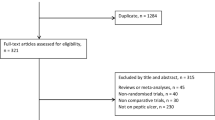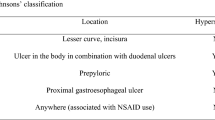Abstract
Purpose
This study aimed to compare the clinical outcomes of the clinical outcomes of laparoscopic and open sutures for peptic ulcer perforation (PPU).
Materials and methods
PubMed, EMBASE, and Cochrane Library databases were searched for eligible studies from inception to March 31, 2023. Odds ratios (OR) and 95% confidence intervals (Cl) were also calculated. The Newcastle–Ottawa Scale (NOS) was used to evaluate the quality of the included studies. This study was performed using the Stata (V.16.0) software.
Results
A total of 29 studies involving 17,228 patients were included in this study. In terms of postoperative outcomes, the laparoscopic group had a shorter postoperative hospital stay (MD = -0.29, 95%CI = -0.44 to -0.13, P = 0.00), less blood loss (MD = -0.45, 95%CI = -0.82 to -0.08, P = 0.02), fewer wound infection (OR = 0.20, 95%CI = 0.17 to 0.24, P = 0.00), fewer pneumonia (OR = 0.59, 95%CI = 0.41 to 0.87, P = 0.01), fewer respiratory complications (OR = 0.26, 95%CI = 0.13 to 0.55, P = 0.00) and lower postoperative morbidity (OR = 0.51, 95%CI = 0.33 to 0.78, P = 0.00). The laparoscopic group had a lower mortality rate (OR = 0.36, 95%CI = 0.27 to 0.49, P = 0.00) than the open group. We also found that the laparoscopic group had a higher overall complication rate than the open group (OR = 0.45, 95%CI = 0.34 to 0.60, P = 0.00).
Conclusion
Laparoscopic repair was associated with a lower risk of mortality than open repair in patients with PPU. Laparoscopic repair may be a better option in patients with PPU.





Similar content being viewed by others
Data availability
All data generated or analyzed during this study are included in this published article.
References
Bertleff MJ, Lange JF (2010) Perforated peptic ulcer disease: a review of history and treatment. Dig Surg 27(3):161–169. https://doi.org/10.1159/000264653
Lau JY, Molyneaux E, Telman MD et al (2011) The plasticity of adolescent cognitions: data from a novel cognitive bias modification training task. Child Psychiatry Hum Dev 42(6):679–693. https://doi.org/10.1007/s10578-011-0244-3
Lanas A, Chan FKL (2017) Peptic ulcer disease. Lancet 390(10094):613–624. https://doi.org/10.1016/S0140-6736(16)32404-7
Mouret P, François Y, Vignal J et al (1990) Laparoscopic treatment of perforated peptic ulcer. Br J Surg 77(9):1006. https://doi.org/10.1002/bjs.1800770916
Lau H (2004) Laparoscopic repair of perforated peptic ulcer: a meta-analysis. Surg Endosc 18(7):1013–1021. https://doi.org/10.1007/s00464-003-8266-y
Odisho T, Shahait AA, Sharza J et al (2023) Outcomes of laparoscopic modified Cellan-Jones repair versus open repair for perforated peptic ulcer at a community hospital. Surg Endosc 37(1):715–722. https://doi.org/10.1007/s00464-022-09306-7
Wang YH, Wu YT, Fu CY et al (2022) Potential use of peptic ulcer perforation (PULP) score as a conversion index of laparoscopic-perforated peptic ulcer (PPU) repair. Eur J Trauma Emerg Surg 48(1):61–69. https://doi.org/10.1007/s00068-020-01552-5
Tulinský L, Sengul D, Sengul I et al (2022) Laparoscopic repair modality of perforated peptic ulcer: less is more? Cureus 14(10):e30926. https://doi.org/10.7759/cureus.30926
Pelloni M, Afonso-Luís N, Marchena-Gomez J, Piñero-González L et al (2022) Comparative study of postoperative complications after open and laparoscopic surgery of the perforated peptic ulcer: Advantages of the laparoscopic approach. Asian J Surg 45(4):1007–1013. https://doi.org/10.1016/j.asjsur.2021.08.059
Moher D, Liberati A, Tetzlaff J et al (2009) Preferred reporting items for systematic reviews and meta-analyses: the PRISMA statement. PLoS Med 6(7):e1000097. https://doi.org/10.1371/journal.pmed.1000097
Dindo D, Demartines N, Clavien PA (2004) Classification of surgical complications: a new proposal with evaluation in a cohort of 6336 patients and results of a survey. Ann Surg 240(2):205–213. https://doi.org/10.1097/01.sla.0000133083.54934.ae
Stang A (2010) Critical evaluation of the Newcastle-Ottawa scale for the assessment of the quality of nonrandomized studies in meta-analyses. Eur J Epidemiol 25(9):603–605. https://doi.org/10.1007/s10654-010-9491-z
Ioannidis JP (2008) Interpretation of tests of heterogeneity and bias in meta-analysis. J Eval Clin Pract 14(5):951–957. https://doi.org/10.1111/j.1365-2753.2008.00986.x
Bergamaschi R (1998) Open vs. laparoscopic repair of perforated peptic ulcer. Surg Laparosc Endosc 8(6):479–80
Siu WT, Leong HT, Law BK et al (2002) Laparoscopic repair for perforated peptic ulcer: a randomized controlled trial. Ann Surg 235(3):313–319. https://doi.org/10.1097/00000658-200203000-00001
Kirshtein B, Bayme M, Mayer T, Lantsberg L et al (2005) Laparoscopic treatment of gastroduodenal perforations: comparison with conventional surgery. Surg Endosc 19(11):1487–90. https://doi.org/10.1007/s00464-004-2237-9
Lunevicius R, Morkevicius M (2005) Comparison of laparoscopic versus open repair for perforated duodenal ulcers. Surg Endosc 19(12):1565–1571. https://doi.org/10.1007/s00464-005-0146-1
Lunevicius R, Morkevicius M (2005) Risk factors influencing the early outcome results after laparoscopic repair of perforated duodenal ulcer and their predictive value. Langenbecks Arch Surg 390(5):413–420. https://doi.org/10.1007/s00423-005-0569-0
Ates M, Sevil S, Bakircioglu E et al (2007) Laparoscopic repair of peptic ulcer perforation without omental patch versus conventional open repair. J Laparoendosc Adv Surg Tech A 17(5):615–619. https://doi.org/10.1089/lap.2006.0195
Bertleff MJ, Halm JA, Bemelman WA et al (2009) Randomized clinical trial of laparoscopic versus open repair of the perforated peptic ulcer: the LAMA Trial. World J Surg 33(7):1368–1373. https://doi.org/10.1007/s00268-009-0054-y
Thorsen K, Glomsaker TB, von Meer A et al (2011) Trends in diagnosis and surgical management of patients with perforated peptic ulcer. J Gastrointest Surg 15(8):1329–1335. https://doi.org/10.1007/s11605-011-1482-1
Motewar A, Tilak M, Patil D et al (2013) Laparoscopic versus open management of duodenal perforation: a comparative study at a District General Hospital. Prz Gastroenterol 8(5):315–319. https://doi.org/10.5114/pg.2013.38735
Çelik MF, Dural AC, Akarsu C et al (2014) The growing role of laparoscopic repair in patients with early diagnosed peptic ulcer perforation. Ulus Cerrahi Derg 30(3):120–124. https://doi.org/10.5152/UCD.2014.2640
Kim JH, Chin HM, Bae YJ et al (2015) Risk factors associated with conversion of laparoscopic simple closure in perforated duodenal ulcer. Int J Surg 15:40–44. https://doi.org/10.1016/j.ijsu.2015.01.028
Shah FH, Mehta SG, Gandhi MD et al (2015) Laparoscopic peptic ulcer perforation closure: the preferred choice. Indian J Surg 77(Suppl 2):403–406. https://doi.org/10.1007/s12262-013-0853-0
Agaba EA, Klair T, Ikedilo O et al (2016) A 10-year review of surgical management of complicated peptic ulcer disease from a single center: is laparoscopic approach the future? Surg Laparosc Endosc Percutan Tech 26(5):385–390. https://doi.org/10.1097/SLE.0000000000000312
Ge B, Wu M, Chen Q et al (2016) A prospective randomized controlled trial of laparoscopic repair versus open repair for perforated peptic ulcers. Surgery 159(2):451–458. https://doi.org/10.1016/j.surg.2015.07.021
Lee DJ, Ye M, Sun KH et al (2016) Laparoscopic versus open omental patch repair for early presentation of perforated peptic ulcer: matched retrospective cohort study. Surg Res Pract 2016:8605039. https://doi.org/10.1155/2016/8605039
Laforgia R, Balducci G, Carbotta G et al (2017) Laparoscopic and open surgical treatment in gastroduodenal perforations: our experience. Surg Laparosc Endosc Percutan Tech 27(2):113–115. https://doi.org/10.1097/SLE.0000000000000376
Mirabella A, Fiorentini T, Tutino R et al (2018) Laparoscopy is an available alternative to open surgery in the treatment of perforated peptic ulcers: a retrospective multicenter study. BMC Surg 18(1):78. https://doi.org/10.1186/s12893-018-0413-4
Smith RS, Sundaramurthy SR, Croagh D (2019) Laparoscopic versus open repair of perforated peptic ulcer: A retrospective cohort study. Asian J Endosc Surg 12(2):139–144. https://doi.org/10.1111/ases.12600
Jamal MH, Karam A, Alsharqawi N et al (2019) Laparoscopy in acute care surgery: repair of perforated duodenal ulcer. Med Princ Pract 28(5):442–448. https://doi.org/10.1159/000500107
Stepanyan SA, Petrosyan AA, Safaryan HH et al (2019) Laparoscopic and open repair for perforated duodenal ulcer: single-center experience. Wideochir Inne Tech Maloinwazyjne 14(1):60–69. https://doi.org/10.5114/wiitm.2018.76281
Vakayil V, Bauman B, Joppru K et al (2019) Surgical repair of perforated peptic ulcers: laparoscopic versus open approach. Surg Endosc 33(1):281–292. https://doi.org/10.1007/s00464-018-6366-y
Fransvea P, Costa G, Lepre L, ERASO (Elderly Risk Assessment and Surgical Outcome) Collaborative Study Group et al (2020) Laparoscopic repair of perforated peptic ulcer in the elderly: an interim analysis of the FRAILESEL Italian multicenter prospective cohort study. Surg Laparosc Endosc Percutan Tech 31(1):2–7. https://doi.org/10.1097/SLE.0000000000000826
Hoshino N, Endo H, Hida K et al (2021) Laparoscopic surgery for acute diffuse peritonitis due to gastrointestinal perforation: a nationwide epidemiologic study using the national clinical database. Ann Gastroenterol Surg 6(3):430–444. https://doi.org/10.1002/ags3.12533
Kim CW, Kim JW, Yoon SN et al (2022) Laparoscopic repair of perforated peptic ulcer: a multicenter, propensity score matching analysis. BMC Surg 22(1):230. https://doi.org/10.1186/s12893-022-01681-1
Wilhelmsen M, Møller MH, Rosenstock S (2015) Surgical complications after open and laparoscopic surgery for perforated peptic ulcer in a nationwide cohort. Br J Surg 102(4):382–387. https://doi.org/10.1002/bjs.9753
Chung KT, Shelat VG (2017) Perforated peptic ulcer - an update. World J Gastrointest Surg 9(1):1–12. https://doi.org/10.4240/wjgs.v9.i1.1
Davenport DL, Ueland WR, Kumar S et al (2019) A comparison of short-term outcomes between laparoscopic and open emergent repair of perforated peptic ulcers. Surg Endosc 33(3):764–772. https://doi.org/10.1007/s00464-018-6341-7
Tarasconi A, Coccolini F, Biffl WL et al (2020) Perforated and bleeding peptic ulcer: WSES guidelines. World J Emerg Surg 7(15):3. https://doi.org/10.1186/s13017-019-0283-9
Tan S, Wu G, Zhuang Q et al (2016) Laparoscopic versus open repair for perforated peptic ulcer: A meta-analysis of randomized controlled trials. Int J Surg 33 Pt A:124–32. https://doi.org/10.1016/j.ijsu.2016.07.077
Quah GS, Eslick GD, Cox MR (2019) Laparoscopic repair for perforated peptic ulcer disease has better outcomes than open repair. J Gastrointest Surg 23(3):618–625. https://doi.org/10.1007/s11605-018-4047-8
Cirocchi R, Soreide K, Di Saverio S et al (2018) Meta-analysis of perioperative outcomes of acute laparoscopic versus open repair of perforated gastroduodenal ulcers. J Trauma Acute Care Surg 85(2):417–425. https://doi.org/10.1097/TA.0000000000001925
Antoniou SA, Antoniou GA, Koch OO et al (2013) Meta-analysis of laparoscopic versus open repair of perforated peptic ulcer. JSLS 17(1):15–22. https://doi.org/10.4293/108680812X13517013317752
Venkat R, Edil BH, Schulick RD et al (2012) Laparoscopic distal pancreatectomy is associated with significantly less overall morbidity compared to the open technique: a systematic review and meta-analysis. Ann Surg 255(6):1048–1059. https://doi.org/10.1097/SLA.0b013e318251ee09
Akin E, Altintoprak F, Akdeniz Y et al (2022) Open versus laparoscopic technique in peptic ulcus perforation, how effective are score systems?Single-center experience and literature review. Ulus Travma Acil Cerrahi Derg 28(10):1437–1441. https://doi.org/10.14744/tjtes.2022.78938. (English)
Kim MG (2015) Laparoscopic surgery for perforated duodenal ulcer disease: analysis of 70 consecutive cases from a single surgeon. Surg Laparosc Endosc Percutan Tech 25(4):331–336. https://doi.org/10.1097/SLE.0000000000000146
Acknowledgements
We acknowledge all authors whose publications are referred to in our article.
Funding
This study was supported by the Chongqing Medical University Program for Youth Innovation in Future Medicine (W0190).
Author information
Authors and Affiliations
Contributions
Data extraction, Zi-Wei Li, Yue Tong, Quan Lv, Xiao-Yu Liu and Kai-Lin Tang; quality assessments, Fei Liu; data analysis, Xu-Rui Liu, Lian-Shuo Li and Wei Zhang; writing-origin draft, Zi-Wei Li; writing-review and editing, Dong Peng, Zi-Wei Li, Kai-Lin Tang, Fei Liu, Xu-Rui Liu, and Wei Zhang. All authors have read and approved the final manuscript. All authors have agreed on the manuscript that will be submitted, gave final approval of the version to be published, and agree to be accountable for all aspects of the work.
Corresponding author
Ethics declarations
Ethics approval and consent to participate
Not applicable.
Consent for publication
Not applicable.
Competing interests
The authors declare that they have no competing interests.
Additional information
Publisher's Note
Springer Nature remains neutral with regard to jurisdictional claims in published maps and institutional affiliations.
Rights and permissions
Springer Nature or its licensor (e.g. a society or other partner) holds exclusive rights to this article under a publishing agreement with the author(s) or other rightsholder(s); author self-archiving of the accepted manuscript version of this article is solely governed by the terms of such publishing agreement and applicable law.
About this article
Cite this article
Li, ZW., Tong, Y., Liu, F. et al. A comparative study on laparoscopic and open surgical approaches for perforated peptic ulcer repair: efficacy and outcomes analysis. Langenbecks Arch Surg 408, 435 (2023). https://doi.org/10.1007/s00423-023-03171-1
Received:
Accepted:
Published:
DOI: https://doi.org/10.1007/s00423-023-03171-1




